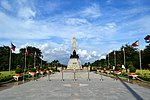Plaza De Mexico (Manila)
Located on this square is the monument to the IV Centenary of the Mexico–Philippines Maritime Expedition donated by the Mexican Secretary of The Navy Shipyards during the 1964 celebrations of the Year of Mexican-Philippine Friendship. On the other side of the square is a statue of Adolfo López Mateos, the President of Mexico who visited the city in 1962.
History

Until 1904, the area of Plaza Mexico contained the walls of the Baluarte de Santo Domingo, which enclosed the Aduana Building and the old Santo Domingo Church. That year, the American colonial government, seeing the need to develop and expand the Pasig River docks, decided to tear down its walls and open up this side of Intramuros. The Magallanes Monument, originally erected in 1848 in the centre of the esplanade called Paseo de Magallanes to honour the Portuguese navigator who had arrived on the country's islands while in search of the Maluku Islands, was transferred to this site fronting the Aduana Building. The monument was destroyed during World War II.
From 1962 to 1964, a series of cultural exchanges between the Philippines and Mexico was held to celebrate the Year of Mexican-Philippine Friendship. This resulted in the creation of several landmarks in the city dedicated to Mexico and the Philippines' long historical and cultural ties to the Latin American country. They include Plaza Mexico and its monuments, the statue of Mexican hero Miguel Hidalgo on Bonifacio Drive, and the renaming of Taft Avenue Extension in Pasay to Mexico Road.
Gallery
See also
References
- ^ "Manual de Organización de la Embajada de México en Filipinas" (PDF). Secretariat of Foreign Affairs (Mexico). Retrieved 18 June 2015.
- ^ "Moving memorials". Manila Bulletin. Retrieved 18 June 2015.
- ^ "Globalization in the Philippines 400 years ago". Philippine Daily Inquirer. Archived from the original on 5 October 2009. Retrieved 18 June 2015.
- ^ "Proclamation No. 320, s. 1964". Official Gazette of the Republic of the Philippines. Retrieved 18 June 2015.



